
Edgar Allan Poe was an American writer, poet, author, editor, and literary critic who is best known for his poetry and short stories, particularly his tales of mystery and the macabre. He is widely regarded as a central figure of Romanticism and Gothic fiction in the United States, and of American literature. Poe was one of the country's earliest practitioners of the short story, and is considered the inventor of the detective fiction genre, as well as a significant contributor to the emerging genre of science fiction. He is the first well-known American writer to earn a living through writing alone, resulting in a financially difficult life and career.

Eliza Poe was an English actress and the mother of the American author Edgar Allan Poe.

Fordham Manor is a neighborhood located in the western Bronx, New York City. Fordham is roughly bordered by East 196th Street to the north, the Harlem River to the west, Fordham Road to the south, and Southern Boulevard to the east. The neighborhood's primary thoroughfares are Fordham Road and Grand Concourse.

"The Bells" is a heavily onomatopoeic poem by Edgar Allan Poe which was not published until after his death in 1849. It is perhaps best known for the diacopic use of the word "bells". The poem has four parts to it; each part becomes darker and darker as the poem progresses from "the jingling and the tinkling" of the bells in part 1 to the "moaning and the groaning" of the bells in part 4.
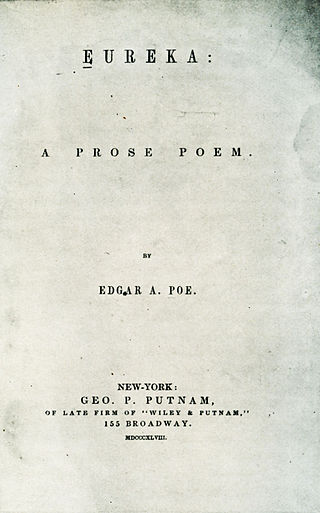
Eureka (1848) is a lengthy non-fiction work by American author Edgar Allan Poe (1809–1849) which he subtitled "A Prose Poem", though it has also been subtitled "An Essay on the Material and Spiritual Universe". Adapted from a lecture he had presented, Eureka describes Poe's intuitive conception of the nature of the universe, with no antecedent scientific work done to reach his conclusions. He also discusses man's relationship with God, whom he compares to an author. Eureka is dedicated to the German naturalist and explorer Alexander von Humboldt (1769–1859).

The Grand Concourse is a 5.2-mile-long (8.4 km) thoroughfare in the borough of the Bronx in New York City. Grand Concourse runs through several neighborhoods, including Bedford Park, Concourse, Highbridge, Fordham, Mott Haven, Norwood and Tremont. For most of its length, the Concourse is 180 feet (55 m) wide, though portions of the Concourse are narrower.
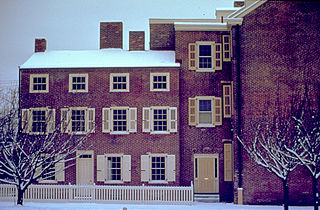
The Edgar Allan Poe National Historic Site is a preserved home once rented by American author Edgar Allan Poe, located at 532 N. 7th Street, in the Spring Garden neighborhood of Philadelphia, Pennsylvania. Though Poe lived in many houses over several years in Philadelphia, it is the only one which still survives. It was designated a National Historic Landmark in 1962.

The Poe Museum or the Edgar Allan Poe Museum, is a museum located in the Shockoe Bottom neighborhood of Richmond, Virginia, United States, dedicated to American writer Edgar Allan Poe. Though Poe never lived in the building, it serves to commemorate his time living in Richmond. The museum holds one of the world's largest collections of original manuscripts, letters, first editions, memorabilia and personal belongings. The museum also provides an overview of early 19th century Richmond, where Poe lived and worked. The museum features the life and career of Poe by documenting his accomplishments with pictures, relics, and verse, and focusing on his many years in Richmond.
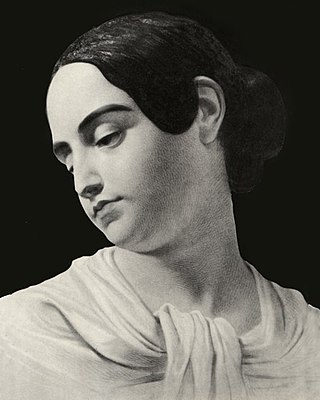
Virginia Eliza Poe was the wife of American writer Edgar Allan Poe. The couple were first cousins and publicly married when Virginia Clemm was 13 and Poe was 27. Biographers disagree as to the nature of the couple's relationship. Though their marriage was loving, some biographers suggest they viewed one another more like a brother and sister. In January 1842, she contracted tuberculosis, growing worse for five years until she died of the disease at the age of 24 in the family's cottage, at that time outside New York City.

Fordham Plaza, originally known as Fordham Square, is a major commercial and transportation hub in the Fordham and Belmont sections of the Bronx in New York City, New York, United States. It is located on the south side of Fordham Road at Third and Webster Avenues, at the eastern end of the commercial strip along Fordham Road that runs past Grand Concourse and Jerome Avenue to about Grand Avenue, and to the west of the Bronx's Little Italy district on Arthur Avenue in Belmont.
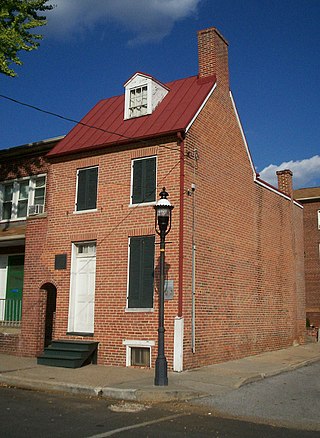
The Edgar Allan Poe House and Museum, located at 203 North Amity St. in Baltimore, Maryland, is the former home of American writer Edgar Allan Poe in the 1830s. The small unassuming structure, which was opened as a writer's house museum in 1949, is a typical row home. It was designated a National Historic Landmark in 1972.

The death of Edgar Allan Poe on October 7, 1849, has remained mysterious in regard to both the cause of death and the circumstances leading to it. American author Edgar Allan Poe was found delirious and disheveled at a tavern in Baltimore, Maryland, on October 3. He sought the help of magazine editor Joseph E. Snodgrass and was taken to the Washington College Hospital, where he was treated for apparent intoxication. Poe had no visitors in the hospital and gave no account of how he came to be in his condition before dying on October 7 at age 40.

Tamerlane and Other Poems is the first published work by American writer Edgar Allan Poe. The short collection of poems was first published in 1827. Today, it is believed only 12 copies of the collection still exist.
The West Bronx is a region in the New York City borough of the Bronx. The region lies west of the Bronx River and roughly corresponds to the western half of the borough.

Elizabeth Fries Ellet was an American writer, historian and poet. She was the first writer to record the lives of women who contributed to the American Revolutionary War.
William Henry Leonard Poe, often referred to as Henry Poe, was an American sailor, amateur poet and the older brother of Edgar Allan Poe and Rosalie Poe.

The works of American author Edgar Allan Poe include many poems, short stories, and one novel. His fiction spans multiple genres, including horror fiction, adventure, science fiction, and detective fiction, a genre he is credited with inventing. These works are generally considered part of the Dark romanticism movement, a literary reaction to Transcendentalism. Poe's writing reflects his literary theories: he disagreed with didacticism and allegory. Meaning in literature, he said in his criticism, should be an undercurrent just beneath the surface; works whose meanings are too obvious cease to be art. Poe pursued originality in his works, and disliked proverbs. He often included elements of popular pseudosciences such as phrenology and physiognomy. His most recurring themes deal with questions of death, including its physical signs, the effects of decomposition, concerns of premature burial, the reanimation of the dead, and mourning. Though known as a masterly practitioner of Gothic fiction, Poe did not invent the genre; he was following a long-standing popular tradition.

The Bronx Library Center is a branch of the New York Public Library in the Fordham section of the Bronx in New York City. The library is located at 310 East Kingsbridge Road between Fordham Road and East 192nd Street, two blocks east of the Grand Concourse. It is the central library for the Bronx, and the largest library in the borough.
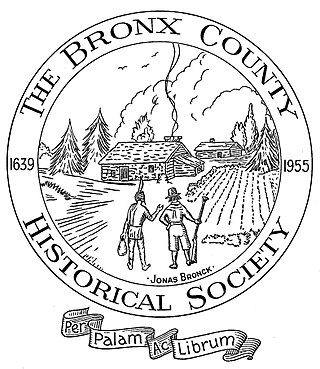
The Bronx County Historical Society is a private non-profit organization that collects and disseminates historical material and information about the New York City borough of the Bronx, as well as southern Westchester County, New York.

Edward Doucet was an American Jesuit academic who was the seventh President of Fordham University.



























